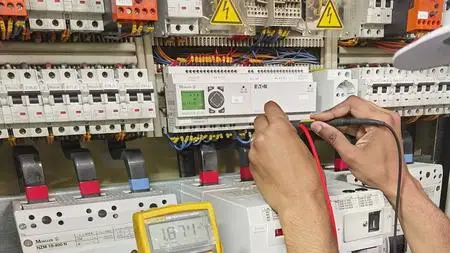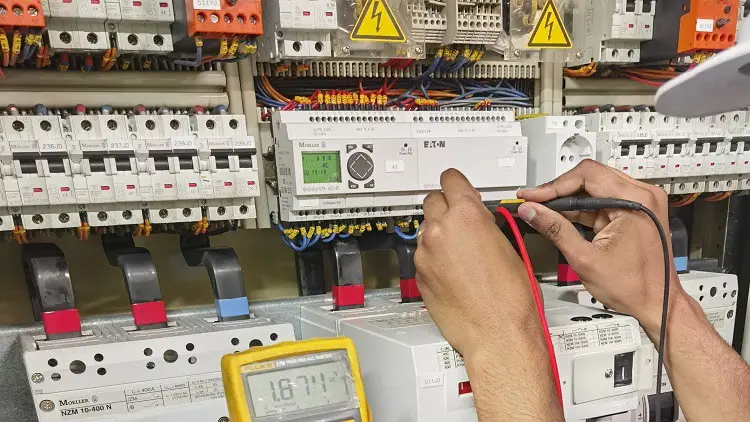Electrical Equipment Maintenance, Testing & Troubleshooting
Duration: 11h 15m | .MP4 1280x720, 30 fps(r) | AAC, 44100 Hz, 2ch | 4.61 GB
Genre: eLearning | Language: English
Duration: 11h 15m | .MP4 1280x720, 30 fps(r) | AAC, 44100 Hz, 2ch | 4.61 GB
Genre: eLearning | Language: English
All About Residencial and Industrial Electrical Equipments, Machines and Systems Maintenance
What you'll learn
Testing Electrical Equipments
Measuring Electrical Quantities
Tools for Electrical Maintenance
Personal Protective Equipments
Circuit Design Rules
Reading Electrical Diagrams for Troubleshooting
Relay Based Control CIrcuits and PLCs
Electrical Panel Design and Wiring
Electrical Maintenance and Testing of Common Equipments
Requirements
Don't Need to Have Basic knowledge of Maintenance and Equipment's
Open Minded
Ready to Learn
Description
This course provides maintenance technicians and non-electrical personnel working in industrial plants and commercial buildings with a thorough foundation in electrical maintenance. Through a combination of illustrated lectures, examples and exercises, students will learn how electrical systems work, how to maintain electrical safety, and how to install and troubleshoot common electrical equipment.
The entire course is valuable for students in university or institutes and professionals as it contains all the concepts of electrical maintenance in Industries and residential facilities.
With simple and easy to understand explanations, the course is
more practical
, dynamic, comprehensive, and presented in the following methodologies:
Lectures with video presentations and attachments.
High quality digital handwritten content.
Examples.
Quiz, practice tests and assignments.
The course is divided in
7
sections:
Course Overview
Introduction and Course Structure.
Electrical Fundamentals
Basic Tools.
Personal Protective Equipment (PPE).
Developing Safe Work Practices.
Resistor Association: Series, Parallel, Wye, Delta and Combination.
Capacitor and Inductor Association: Series and Parallel.
Points Movement and Short-Circuit, Branches, Nodes, and Loops.
Generation of DC, Single & Three-Phase AC and their Circuit Operating Principle.
Power System.
Measuring and Testing
How to Measure Ω, A, V, W, Hz and rpm.
Attention When Measuring Ω, A, V.
Multimeter, Clamp On Meter, Oscilloscope, Power Quality and Phase Sequence Meter.
Insulation Resistance Meter.
How to Measure Insulation Resistance in Motor, Transformer and MV/HV Insulator.
How to Choose Insulation Resistance Test Voltage and Analyze Results.
Simulation of Ω, A, V, W, Hz Metering and Wave Analyzer With Oscilloscope.
Basic Skills and knowledge
for Electrical Circuit Troubleshooting
Electrical Schematic Diagram Symbology.
Voltage Levels used in LV Electrical Circuits
.
Local and Remote Control.
Manual and Automatic Control.
Sensors and Transducers.
Power, Control and Signaling Circuits: Contactors, Relays, Interlocks, etc.
Fuse, Circuit Breaker, Overload, Voltage and Frequency Relays.
Electrical Timer and Latch Relays.
Electrical Switchboards Accessories: Terminal Block, Din Rail, Cable Trunking.
Buttons, Switches, Selectors, Siren, Signaling LED.
Design of Power, Control and SIgnaling Circuits 1.
Design of Power, Control and SIgnaling Circuits 2.
AC and DC Motor Starting and Speed Control Methods.
Example 1: Star-Delta Starter.
Example 2: DC Motor with Separate Excitation Starting.
Fundamental Rules for Creating and Reading Electrical Diagrams.
Basics of Ladder Diagram and PLC Programming.
Practical Circuit Wiring and Panel Design
Water Refill Tank Panel Design and Wiring.
PLC Controlled Water Refill Tank Panel Design and Wiring.
Assigment: PLC Ladder Diagram for Previous Lecture.
Maintenance, Testing and Troubleshooting of Common Electrical Equipments
Electrical Maintenance and Testing of Common Equipments.
Final Considerations
Contact for support.
What the student can expect from instructor?
Clear in explaining theories and practical exercises
Available to clarify doubts and explanations about specific course content
Practical examples of the application of circuit analysis in EE employment
Students completing the course will emerge with the ability to reduce equipment downtime, improve facility safety, and fix problems on their own.
Who this course is for:
Electrical Engineer
Electrical Technician
Electronic Engineer
Electronic Technician
Mechanical Engineer
Mechanical Technician
Maintenance Engineer
Maintenance Technician
Mechatronic Engineering
Mechatronic Technicians
Automation Engineering
Automation Technicians
Anyone Who Wants To Learn Electricity
More Info



